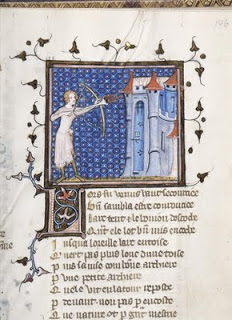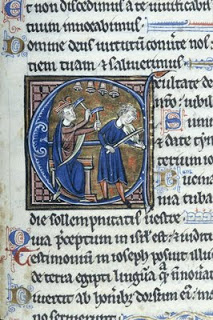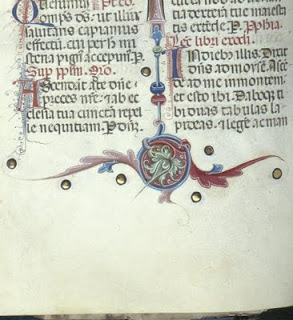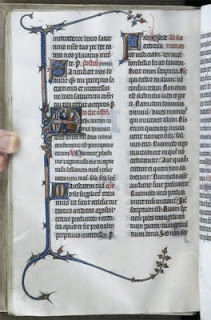Medieval History

Roman de la Rose, Princeton Garrett 126, miniature, column, fol. 146r, detail, mid 14th century, parchment, Île-de-France, Paris
Below miniature in right column, initial L decorated with foliate ornament and tendrils, at beginning of text, LORS FU VENUS HAUT SECOURCIEE / BIEN SAMBLA ESTRE COUROUCIEE ...
Le Roman de la Rose attributed to Jean de Meun is one of the most important medieval texts. Unlike so many texts there are dozens of manuscripts extant of Roman de la Rose. Several scholars have tried to attribute the allegories in this tale to La Dame a la Licorne, but in my mind, they aren't convincing arguments.
In this illumination I love Venus' languid, elegant form, the representational architecture and especially the initial L.

Psalter, initial D. fol.55v, whole page, c. 1300, parchment, English. Love the decorations filling in the blank spaces, classic medieval horror vacui.

Psalter, initial D, fol. 109v, whole page, c. 1300, parchment, English

Psalter of Poitiers, Sainte-Croix, initial E, fol. 69r, 1250 - 1260, Île-de-France, Paris
Psalm 081 (Vulg., 080).
David and Musicians -- David, crowned, sits on bench, with hammer in each hand playing four bells suspended above, beside musician, wearing fillet, with bow playing viol.
Scene against gold background, within initial E decorated with patterned spandrels.
Initial E, Incipit; OT, Psalm 081:01 (Vulg., 080:02); EXULTATE DEO ADIUTORI NOSTRO IUBILATE ...., Latin
So interesting to explore images of music and music makers in medieval manuscripts, and of course, here related to David.


Scene against gold background, within initial M decorated with foliate ornament, and with marginal foliate extensions.
Beginning of Introit for Mass of Apostle Andrew.
Initial M, Rubric; IN DIE OFFICIUM, Latin
Initial M, Incipit; MICHI AUTEM NIMIS HONORATI SUNT AMICI TUI DEUS ...., Latin
Written and illuminated in Paris in the early 14th century for a Dominican nunnery, as so indicated on f. 349v: Rubric at end of 2nd responsory of the burial service, Ibi debemus flectere genua sed tantum pro sorore nostra, followed by Domine miserere super peccatrice.
The information about these pieces and the images are from ArtStor.
- Manuscript Scholar Gives Illuminating Talk
Not every rare book scholar gets the opportunity to hold the object of her research. Professor Anne Rudloff Stanton, chair of the art history and archaeology department at University of Missouri Columbia, is one of the lucky few. Stanton, whose research...
- Sixteenth-century Norwegian Illuminated Manuscript
Jónsbók, Lögbok Islendinga, initial F, fol. 3v, Whole Page. Parchment, 1580. Initial F, Incipit; FRJDUR OG BLEZAN VORS GUDZ ALMATTUGS: FAUDUR OG FRELSARA JHESU CHRISTI ASAMT MEDUR HINUM HELGA ANNDA SIE MED OSS AULLUMM .......
- Mermaids
Roman book of hours, whole page, folio 186r. End of fifteenth century, made in Venice or Padua. Historiated initial (D)omine with the Holy Spirit above. Floral border with mermaid and dolphin. Pendant of a mermaid, German. 1580-1590, enameled gold,...
- Not A Saint - But A Sinner!
Two bright and acute thinkers put forth that the woman in the last post is not a saint - but one of the Bible's most infamous sinners: Bathsheba. But our Bathsheba would be a most demure temptress, fully clothed as she is. She must have had...
- Irish Illumination From The 8th-9th Century
Illuminated page from the MacRegol or Rushworth Gospels. 9th century, beginning (before 822), parchment, Irish. Written in Old English and Latin, and illuminated by MacRegol (d. 822), abbot of Birr, Co. Offaly. Capital illumination by Philippus Presbiter,...
Medieval History
some illumination

Roman de la Rose, Princeton Garrett 126, miniature, column, fol. 146r, detail, mid 14th century, parchment, Île-de-France, Paris
Scene, Venus attacking Castle -- Venus, wearing garment, with bow shoots torch at castle with closed gate decorated with ironwork. Scene against diapered background within frame of miniature decorated with tendrils in right column.
In bottom of left column, rubric caption of scene, CI COMME VENUS TRAIT OU CHASTEL I BRANDON DE FEU POR EMBRASER CEULZ QUI SONT DEDENZ.Below miniature in right column, initial L decorated with foliate ornament and tendrils, at beginning of text, LORS FU VENUS HAUT SECOURCIEE / BIEN SAMBLA ESTRE COUROUCIEE ...
Le Roman de la Rose attributed to Jean de Meun is one of the most important medieval texts. Unlike so many texts there are dozens of manuscripts extant of Roman de la Rose. Several scholars have tried to attribute the allegories in this tale to La Dame a la Licorne, but in my mind, they aren't convincing arguments.
In this illumination I love Venus' languid, elegant form, the representational architecture and especially the initial L.

Psalter, initial D. fol.55v, whole page, c. 1300, parchment, English. Love the decorations filling in the blank spaces, classic medieval horror vacui.


Language: Latin
Script: Gothic, textura semiquadrataPsalm 081 (Vulg., 080).
David and Musicians -- David, crowned, sits on bench, with hammer in each hand playing four bells suspended above, beside musician, wearing fillet, with bow playing viol.
Scene against gold background, within initial E decorated with patterned spandrels.
Initial E, Incipit; OT, Psalm 081:01 (Vulg., 080:02); EXULTATE DEO ADIUTORI NOSTRO IUBILATE ...., Latin
So interesting to explore images of music and music makers in medieval manuscripts, and of course, here related to David.

Missal, intial P, fol. 52v, whole page, Venetian, 1350-1374, parchment. As I understand it, velum is made of unborn calfskin, and parchment is from lambs, goats or calves. Similar creation processes, however. This detail smacks very Italian to me.

Missal, initial M, fol. 213v, whole page, c. 1300, French Dominican Convent
Script: Gothic, textura quadrataApostle, Andrew: Crucifixion -- Two executioners, one wearing cap, bind arms and legs of Andrew to horizontal cross.Scene against gold background, within initial M decorated with foliate ornament, and with marginal foliate extensions.
Beginning of Introit for Mass of Apostle Andrew.
Initial M, Rubric; IN DIE OFFICIUM, Latin
Initial M, Incipit; MICHI AUTEM NIMIS HONORATI SUNT AMICI TUI DEUS ...., Latin
Written and illuminated in Paris in the early 14th century for a Dominican nunnery, as so indicated on f. 349v: Rubric at end of 2nd responsory of the burial service, Ibi debemus flectere genua sed tantum pro sorore nostra, followed by Domine miserere super peccatrice.
The information about these pieces and the images are from ArtStor.
- Manuscript Scholar Gives Illuminating Talk
Not every rare book scholar gets the opportunity to hold the object of her research. Professor Anne Rudloff Stanton, chair of the art history and archaeology department at University of Missouri Columbia, is one of the lucky few. Stanton, whose research...
- Sixteenth-century Norwegian Illuminated Manuscript
Jónsbók, Lögbok Islendinga, initial F, fol. 3v, Whole Page. Parchment, 1580. Initial F, Incipit; FRJDUR OG BLEZAN VORS GUDZ ALMATTUGS: FAUDUR OG FRELSARA JHESU CHRISTI ASAMT MEDUR HINUM HELGA ANNDA SIE MED OSS AULLUMM .......
- Mermaids
Roman book of hours, whole page, folio 186r. End of fifteenth century, made in Venice or Padua. Historiated initial (D)omine with the Holy Spirit above. Floral border with mermaid and dolphin. Pendant of a mermaid, German. 1580-1590, enameled gold,...
- Not A Saint - But A Sinner!
Two bright and acute thinkers put forth that the woman in the last post is not a saint - but one of the Bible's most infamous sinners: Bathsheba. But our Bathsheba would be a most demure temptress, fully clothed as she is. She must have had...
- Irish Illumination From The 8th-9th Century
Illuminated page from the MacRegol or Rushworth Gospels. 9th century, beginning (before 822), parchment, Irish. Written in Old English and Latin, and illuminated by MacRegol (d. 822), abbot of Birr, Co. Offaly. Capital illumination by Philippus Presbiter,...
